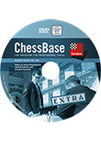Caruana’s cool play
 ChessBase Magazine 182 Review
ChessBase Magazine 182 Review
- Languages: English, German
- Delivery: Download, Post
- Level: Any
- Price: €19.95
€16.76 / $18.10 without VAT (for customers outside the EU)
As I write these lines, the Candidates’ Tournament has drawn to a tumultuous close. Fabiano Caruana has deservedly emerged as the Challenger. It is only appropriate that the review of this issue should begin with a game by him.
Readers may recall, Nepomniachtchi was leading in the London Chess Classic last year. With a last-minute sprint, Fabiano finished with the same number of points as Ian and the two had to play a blitz match to resolve the tie. This issue of ChessBase Magazine includes all games from the tournament and I found the mini-match very interesting. Soon after the tournament, Caruana was interviewed by ChessBase and Fabiano’s response was revealing, both for his modesty and candour.
A terrific encounter in which the loser deserves as much credit as the winnner. One can only admire the fighting spirit of the Black monarch who marched through enemy territory (with two pawns for company) under a hail of bullets. "Nepo’s" admirers can also check out his annotations to his win over Anand in this issue.
Magnus suffered in this tournament, though he still managed to beat Adams and Aronian in the end. As noteworthy is his fighting draw with Nakamura. The game is annotated by Yermolinsky and also commented on in a video by Daniel King.
Play like Carlsen, avoid theory but without being passive or losing the initiative.
Azeris conquer Europe!
This issue also includes games from European Team Championship (won by Azerbaijan ahead of Russia and Ukraine) FIDE Grand Prix Palma 2017 (won by Aronian with Jakovenko and Nakamura following behind) and the Russian Championship (won by Svidler for the record eighth time). From the sporting point of view, the Azeri victory at the European Team Championship is perhaps the most important event reported in this issue. Few expected the Azeris to recover from the disastrous match with Italy when they were taken down with the score of 1½:2½. That defeat spurred them on to fight with fierce determination round after round. The turning point came in the decisive duel with Russia in the penultimate round. Here they beat their rivals with the score of 3-1. Mamedyarov prevailed over Grischuk and Radjabov downed Nepomniachtchi. There still remained the last round and they sailed through with an even score, 2:2 against Ukraine. At last, they had made it.

The Azerbaijani team | Photo: EuroTeams2017.com
Among all the games I found the Grischuk-Mamedyarov encounter very fascinating. In this issue, it is annotated by Mihail Marin. Meanwhile, I happened to find a commentary on the game by Mamedyarov himself in “64 Review”, not to mention analysis by Anish Giri in “New in Chess” Magazine. I have made judicious use of all the three here.
The rivals spent quite some time analysing the lines after the game. At the board, it was not easy for Grischuk to find his bearings through a hurricane of complications.
The line was seen 50 years before!
In the analysis of this game, Marin mentions that it was Lajos Portisch who first played this line.
When I checked MegaBase I found, it was played way back in 1968 in Wijk aan Zee. The Hungarian veteran won it against Korchnoi who went on to win the tournament.
 For Leonid Kritz, it is clear that the only chances for an advantage for White in the Modern Steinitz Variation lie in 5.0-0.
For Leonid Kritz, it is clear that the only chances for an advantage for White in the Modern Steinitz Variation lie in 5.0-0.In retrospect, this is a game in which Korchnoi would have preferred to play Black. This is how the old Viktor used to catch his opponents off guard in the middlegame.
As for Portisch, although he won the game, he was far from happy with his innovation and concluded, White was better. He never played it again. So it is to the credit of Mamedyarov that he revived it when everything was at stake.
To return to this magazine, there are as many as twelve opening surveys ranging from the Sicilian to the Catalan. Among them, Robert Ris’ treatment of the Benko Gambit and Evgeny Postny’s analysis of a rare line in the Reti deserve special mention.
How to beat Magnus
 47.383 games and videos by Adrian Mikhalchishin, Georgios Souleidis & Yannick Pelletier
47.383 games and videos by Adrian Mikhalchishin, Georgios Souleidis & Yannick PelletierApart from these surveys, there are regular sections on opening traps, middlegame tactics and endings.There is much else in this DVD that deserves to be explored. In all, there are 1768 OTB games of which 157 are annotated. Among them, Anand’s analysis of his win over Carlsen in the World Rapid Championship* deserves special mention. I am sure, both Carlsen and Caruana would take a look at that analysis now that the world championship is due. Other annotators in the current issue include Radjabov, Wesley So and Bologan, to mention a few. A major contribution is made by Alexander Yermolinsky who has annotated 24 games. He is followed by Daniel Fernandez with 20 games.
Recommended.
* The rest of the games from the World Rapid and the World Blitz Championship are included in the next issue, CBM 182 Extra.
Enjoy the best moments of recent top tournaments (London, Grand Prix Palma, European Teams) with analysis of top players. In addition you'll get lots of training material. For example 12 new suggestions for your opening repertoire.
See also:


















 ChessBase Magazine 182 Review
ChessBase Magazine 182 Review





